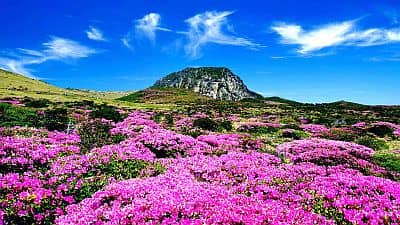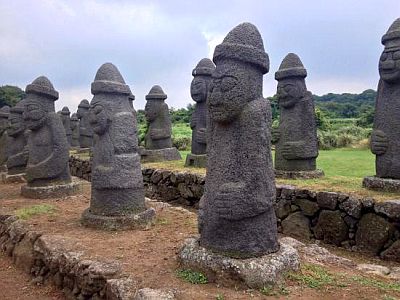Select units of measurement for the temperature and rainfall tables (metric or imperial).
Average weather, temperature, rainfall, sunshine hours
The climate of Jeju (Jeju-do), an island located to the south of Korea, is
temperate humid, with quite mild winters and hot, muggy and rainy summers. Like the rest of Korea, the island is affected by the
monsoon circulation: in winter, the northwest cold currents prevail (which are initially dry, but before they reach the island, they have to pass above a stretch of sea quite large), while in summer, hot and humid currents of tropical origin prevail. Spring and autumn are transitional periods, mild and pleasant, especially the month of October.
The
rains are plentiful, in fact they amount to 1,500 millimeters (60 inches) per year on the northern coast (the most sheltered, at least in the warm season, which is dominated by southern currents), while they reach 1,900 mm (75 in) on the southern and eastern coasts.
Owing to both the southern location and the influence of the sea,
winter in Jeju-do is milder than in the Korean peninsula, but it is also rainier, in addition, the wind can heighten the feeling of cold. There are quite mild periods, with highs above 10 °C (50 °F), which alternate with cold periods, with wind and rain, highs around 5/7 °C (41/45 °F) or less, and possible falls of sleet or snow. However, snowfalls are typically light, as well as night frosts. In January 2016, there has been an unusual snowfall of 12 centimeters (4.7 in), the most abundant since 1984, which led to the closure of the airport, and at night, the temperature dropped to -5.8 °C (21.6 °F).
Summer is hot and humid, though fortunately the sea breeze blows, relieving the heat. There can be periods of good weather, with highs about 32/34 °C (90/93 °F), tropical nights and high humidity, but also periods of bad weather due to the summer monsoon.
Here are the temperatures of
Jeju City, located on the northern coast, where the airport is also located.
Jeju City - Average temperatures (1991-2020) |
| Month | Min | Max | Mean |
|---|
| January | 3.7 | 8.6 | 6.2 |
|---|
| February | 4 | 9.9 | 7 |
|---|
| March | 6.6 | 13.3 | 10 |
|---|
| April | 10.8 | 18 | 14.4 |
|---|
| May | 15 | 22.1 | 18.6 |
|---|
| June | 19.1 | 24.9 | 22 |
|---|
| July | 23.7 | 29.3 | 26.5 |
|---|
| August | 24.8 | 30.1 | 27.4 |
|---|
| September | 20.9 | 26.1 | 23.5 |
|---|
| October | 15.7 | 21.6 | 18.6 |
|---|
| November | 10.4 | 16.4 | 13.4 |
|---|
| December | 5.6 | 11 | 8.3 |
|---|
| Year | 13.4 | 19.3 | 16.35 |
|---|
Here is the average rainfall in Jeju City.
Jeju City - Average precipitation| Month | Days |
|---|
| January | 70 | 12 |
|---|
| February | 55 | 10 |
|---|
| March | 90 | 10 |
|---|
| April | 90 | 9 |
|---|
| May | 95 | 10 |
|---|
| June | 170 | 12 |
|---|
| July | 210 | 12 |
|---|
| August | 270 | 13 |
|---|
| September | 230 | 11 |
|---|
| October | 95 | 7 |
|---|
| November | 70 | 10 |
|---|
| December | 55 | 12 |
|---|
| Year | 1500 | 128 |
|---|
Here are the temperatures of
Seogwipo, located on the southern coast. As you can see, the temperatures are slightly milder.
Seogwipo - Average temperatures (1991-2020) |
| Month | Min | Max | Mean |
|---|
| January | 4.1 | 10.8 | 7.4 |
|---|
| February | 4.8 | 11.8 | 8.3 |
|---|
| March | 7.5 | 14.7 | 11.1 |
|---|
| April | 11.6 | 18.6 | 15.1 |
|---|
| May | 15.8 | 22.3 | 19 |
|---|
| June | 19.5 | 24.7 | 22.1 |
|---|
| July | 23.8 | 28.3 | 26 |
|---|
| August | 24.9 | 30.1 | 27.5 |
|---|
| September | 21.5 | 27.4 | 24.4 |
|---|
| October | 16.4 | 23.5 | 20 |
|---|
| November | 11.2 | 18.4 | 14.8 |
|---|
| December | 6.2 | 13.1 | 9.6 |
|---|
| Year | 14 | 20.4 | 17.15 |
|---|
And here is the average rainfall in Seogwipo. As mentioned, the rains are more abundant on the southern coast.
Seogwipo - Average precipitation| Month | Days |
|---|
| January | 60 | 10 |
|---|
| February | 80 | 10 |
|---|
| March | 130 | 10 |
|---|
| April | 185 | 10 |
|---|
| May | 225 | 11 |
|---|
| June | 270 | 13 |
|---|
| July | 275 | 14 |
|---|
| August | 315 | 14 |
|---|
| September | 210 | 11 |
|---|
| October | 100 | 6 |
|---|
| November | 85 | 8 |
|---|
| December | 55 | 9 |
|---|
| Year | 1990 | 125 |
|---|
The amount of
sunshine in Jeju is not excellent, however, there are two peaks, one in spring (April-May) and the other in autumn (October). The cloudiest period is the first part of the rainy season (June-July). On the south coast, winter is a fairly sunny season, as you can see in the table concerning the hours of sunshine per day in Seogwipo.
Seogwipo - Sunshine hours| Month | Average | Total |
|---|
| January | 5 | 155 |
|---|
| February | 5.5 | 160 |
|---|
| March | 6 | 185 |
|---|
| April | 6.5 | 195 |
|---|
| May | 6.5 | 205 |
|---|
| June | 4.5 | 135 |
|---|
| July | 4.5 | 145 |
|---|
| August | 6 | 190 |
|---|
| September | 6 | 175 |
|---|
| October | 6.5 | 210 |
|---|
| November | 5.5 | 165 |
|---|
| December | 5 | 160 |
|---|
| Year | 5.7 | 2075 |
|---|
However, in the north of the island, directly exposed to the winter monsoon, the sky is often cloudy even in this season.
Jeju City - Sunshine hours| Month | Average | Total |
|---|
| January | 2.5 | 70 |
|---|
| February | 4 | 110 |
|---|
| March | 5.5 | 165 |
|---|
| April | 6.5 | 195 |
|---|
| May | 7 | 210 |
|---|
| June | 5.5 | 160 |
|---|
| July | 6 | 190 |
|---|
| August | 6.5 | 195 |
|---|
| September | 5.5 | 160 |
|---|
| October | 5.5 | 175 |
|---|
| November | 4 | 125 |
|---|
| December | 2.5 | 80 |
|---|
| Year | 5 | 1835 |
|---|
On the island of Jeju, the
sea is warm enough for swimming from July to September, with a maximum in August. Here are the average sea temperatures.
Jeju City - Sea temperature| Month |
|---|
| January | 14 |
|---|
| February | 13 |
|---|
| March | 12.5 |
|---|
| April | 13.5 |
|---|
| May | 16.5 |
|---|
| June | 20.5 |
|---|
| July | 24.5 |
|---|
| August | 27 |
|---|
| September | 25.5 |
|---|
| October | 22 |
|---|
| November | 19"> |
|---|
| December | 16.5 |
|---|
| Year | 18.7 |
|---|

The interior of the island is occupied by a mountain,
Mount Halla, an extinct volcano of 1,950 meters (6,398 feet), which is also the highest mountain of Korea. The area is protected in the
Hallasan National Park.
Here are the average temperatures of Witse Oreum, 1,672 meters (5,486 ft) above sea level, where the roads at the base of the volcano end.
Witse Oreum - Average temperatures (2003-2009) |
| Month | Min | Max | Mean |
|---|
| January | -9.1 | -1.6 | -5.4 |
|---|
| February | -7.5 | 0.9 | -3.3 |
|---|
| March | -5.1 | 3.4 | -0.8 |
|---|
| April | 0.7 | 10 | 5.4 |
|---|
| May | 5.7 | 14.9 | 10.3 |
|---|
| June | 10.4 | 18.1 | 14.2 |
|---|
| July | 14.7 | 20.3 | 17.5 |
|---|
| August | 14.5 | 20.6 | 17.6 |
|---|
| September | 11 | 18.1 | 14.6 |
|---|
| October | 4.3 | 13.2 | 8.8 |
|---|
| November | -0.9 | 6.8 | 2.9 |
|---|
| December | -6.6 | 0 | -3.3 |
|---|
| Year | 2.7 | 10.4 | 6.55 |
|---|
Mount Halla is rain-soaked: up to 4,700 mm (185 in) of rain fall per year; rainfall exceeds 300 mm (12 in) per month from May to October, with a maximum of as high as 835 mm (33 in) in August. Although the winter is the driest season, there is still room for heavy snowfalls, so the top can remain snow-capped also in spring. Tourists on the mountain slopes go skiing (though there are no lifts, and skiing is actually forbidden), and sledding. Here is the average precipitation.
Witse Oreum - Average precipitation| Month | Days |
|---|
| January | 45 | |
|---|
| February | 130 | |
|---|
| March | 300 | |
|---|
| April | 425 | |
|---|
| May | 655 | |
|---|
| June | 650 | |
|---|
| July | 740 | |
|---|
| August | 835 | |
|---|
| September | 525 | |
|---|
| October | 125 | |
|---|
| November | 165 | |
|---|
| December | 65 | |
|---|
| Year | 4670 | |
|---|
On the island, the characteristic
Dol hareubang ("Stone grandfathers"), basalt statues, up to 3 meters (10 feet) high, are found.

From July to early October (and occasionally, also in the second half of June), Jeju can be affected by
typhoons, the tropical cyclones of south-east Asia, which can bring strong winds and torrential rains, as happened for example with typhoon Maemi in September 2003, typhoon Sanba in September 2012, and typhoon Chaba in early October 2016.
2016.
Best Time
The best times to visit Jeju Island are spring and autumn, and in particular from mid-April to late May and mid-October to mid-November. In summer, temperatures are milder in the mountains, but the rains are abundant and typhoons can pass.